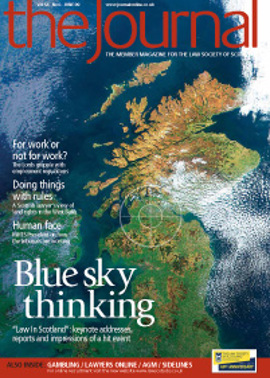Killer question

Murder by fireraising?
One might reasonably have thought by this time in the evolution of the common law of crimes that the most serious crime of all would have been free of definitional problems. Indeed, after the decision in Drury v HM Advocate 2001 SLT 1013, when a requirement of “wickedness” was added to the mens rea required in cases of murder committed by intentional killing, things seemed to go as quiet as they had been for some years.
But now an unresolved issue has confronted the High Court: is it always murder when someone is killed as a result of wilful fireraising? We will have to wait for the answer, for Petto v HM Advocate [2009] HCJAC 43 (30 April 2009) is heading for a bench of five judges.
There, the appellant had actually pleaded guilty to murder, on an indictment in which it was alleged that he and others had poured petrol throughout a ground floor flat in a block of tenements. This was said to have caused an explosion and an extensive fire which entered the common close, stairwell and other flats, as a result of which a resident in one of them died. However on appeal he sought to withdraw his plea of guilty on the basis that the narrative of the charge did not describe the crime of murder, but only culpable homicide.
His argument was to the effect that (a) the libel lacked any averment that the appellant knew there was anyone inside the block of flats at the time (even although it was conceded that he must have known that the flats would have been occupied at the material time); and (b) there was no allegation he had committed any assault directed at anyone.
Now of course murder can be committed by someone who
displays wicked recklessness, something almost invariably inferred from the degree of violence used. In the present case the Crown argument was that the circumstances of the fireraising were so extreme that they did display that feature; and when taken along with knowledge that there were indeed other residents in the flat, the crime was one of murder.
In deciding to remit the case to a larger court, the appeal court reviewed the law of murder as associated with wilful fireraising and whether the wilful act which must be proved in all cases ought to be confined to an assault in the narrow sense of the word. Did such a wilful action have to be directed exclusively at the individual who is killed? Was Macdonald (4th ed, p 91) right to state (without vouching) that where death results from the perpetration of any serious and dangerous crime, murder may be committed although there is no specific intent to kill? The court noted that the doctrine of constructive malice had been discarded in HM Advocate v Purcell [2007] HCJ 13; 2008 JC 131, and concluded that to hold that the present indictment was apt to support a charge of murder might be seen as an extension of the existing categories, for which course of action there was insufficient authority. We await the next hearing with interest.
Acting in defence of another
It is trite law that for a special defence of self defence to be successful in a case of assault (at least where it is the person on trial who has sought to defend himself), three conditions must be satisfied. The accused must of course be attacked or have reason to believe he is in imminent danger of attack; he can only use violence as a last resort; and any necessary force that he uses must be reasonable. A jury must always be directed on these matters; but what about jury directions where the accused uses violence to ward off an attack on another person? There is a surprising dearth of authority on what is needed in such cases, but Dewar v HM Advocate [2009] HCJAC 40 (23 April 2009) at least points the way to a solution.
There, the accused was convicted
of assault, having previously run a special defence to the effect that the blows which he used were struck in defence of one of his co-accused who was allegedly being attacked with a knife. His appeal succeeded because the sheriff had misdirected the jury on the second condition noted above: this was not a case where the accused himself was under attack and was thus under an obligation to use any safe means of escape (which was how the directions had been couched); it was one where “running away” was inconsistent with the entitlement in certain circumstances to intervene in defence of another.
So what needs to be said? None
of the three cases cited (HM Advocate v Carson 1961 SLT 21, Fitzpatrick v
HM Advocate 1997 SLT 796, and Barrie v HM Advocate 2002 SLT 1053) provided an answer, and no hard and fast rules emerged in Dewar. All that is said is that while the actual directions necessary depend on the circumstances, a trial judge must avoid leaving the jury with the understanding that the accused cannot plead self defence in cases of this kind, if he has not taken the opportunity to distance himself from the attack on the person to whose defence he decides to go.
Diminished responsibility and the punishment part
Perhaps the most interesting sentencing case of recent weeks is Caldwell v HM Advocate [2009] HCJAC 44 (8 May 2009), where the accused was convicted of murdering a child, after the jury had rejected his plea of diminished responsibility. The trial judge imposed the mandatory life sentence with a punishment part of 20 years, the latter decision being that which was appealed.
The appeal was dismissed, although the three appeal judges were divided as to the reasons. Lords Osborne and Mackay of Drumadoon agreed that the trial judge had been wrong, in fixing the punishment part, in not taking into account evidence of the accused’s abnormality of mind falling short of the degree necessary for a plea of diminished responsibility to succeed, while Lady Paton thought the approach of the trial judge had been correct. The court then considered a supplementary report from the trial judge, indicating what evidence he would have accepted (had it been necessary to do so), and in the light of this Lords Osborne and Mackay decided that the punishment part should stand. Lady Paton also decided that the appeal should be refused, first because she thought the trial judge had taken the correct approach; but esto he had not, then the appeal should also fail for the reasons stated by the other judges.
The difference in judicial view appears to have rested on whether, by requiring a trial judge in a contested case to take account of the accused’s mental condition where the jury had rejected whatever evidence might have supported the plea of diminished responsibility, the appropriate punishment part should be fixed by reference to such other medical evidence as the judge was prepared to accept.
Procedural hearings in the appeal court
It is abundantly clear that appeal judges are becoming extremely concerned about delays in the hearing of criminal appeals, a problem which the 2002 reforms sought to address. There has now been a succession of cases where adverse comments have been made from the bench about how the system of procedural hearings is operating; among the defects highlighted in cases such as McCarthy v HM Advocate 2008 SCCR 902 and DS v HM Advocate 2008 SCCR 929 have been the tendency to use procedural hearings as a device to embark on inquiries unrelated to the grounds of appeal which have passed the sift, or to do additional work which could have been done earlier.
In the result many cases set down for procedural hearings have been dropped from the roll and have never come before a judge, far less an appeal bench, for many months or even years. Another recent problem has been the practice (rarely condoned in former times) of the appellant instructing new counsel for the appeal, for no apparent good reason.
In recent weeks, two further cases have provided evidence of the court’s disquiet: in Johnston and Woolard v HM Advocate [2009] HCJAC 38 (21 April 2009), the court carefully analysed rule 15.5A of the 2002 Act of Adjournal, concluding that if it is intimated that the appeal is not ready to proceed, the procedural hearing should nonetheless proceed, with the court making decisions about further progress; while in Gordon v HM Advocate [2009] HCJAC 52 (24 April 2009), Lord Carloway described a straightforward case in which there were clear and unamended grounds of appeal as having “languished in procedural hearings for two years”.
No doubt more procedural reform is on the way, since the delays need to be urgently addressed; as Lord Carloway said at para 17, an appeal process ought to take a considerably shorter period of time than that culminating in the trial at first instance.
Charles Stoddart is a criminal law author and a former sherifff
In this issue
- Spanish executry law – cross border issues
- The Scottish Parliament’s Emergency Bill procedure
- One year on
- Unequal before the law (1)
- Ian Smart's inauguration speech
- Your new First XI
- Dangerous loophole
- Unlocking the rule of law
- Our guiding light
- A hit for the conference
- Of chairs, trains and escalators
- Unequal before the law
- Matters of the mind
- New game, new rules
- Advance on all fronts
- Making openness work
- The First XI
- Society parleys with the OFT
- Professional Practice Committee
- Committees: the unsung heroes
- Find a client?
- Platform for success?
- Ask Ash
- Constant foe
- Killer question
- A time to be inventive
- Deep pockets required?
- Win some, lose some
- New client - new problems
- Website review
- Book reviews
- A business view






